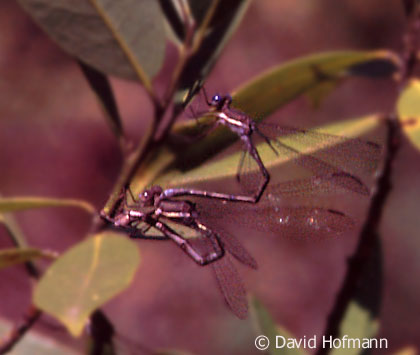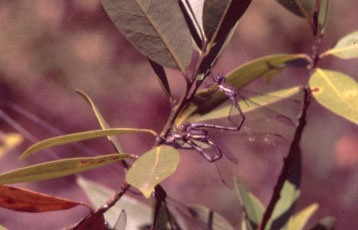These Great Spreadwings Archilestes grandis were observed by Kathy Biggs and
David Hofmann on October 8, at Courtship Creek in the Fairfield Osborn Preserve out of Cotati, Sonoma
Co., CA


We drove up to the Fairfield Osborn Preserve (access by reservation only) where I've been
conducting a dragonfly census to see if we could find Great Spreadwings
flying.. Just two yrs ago we found CA Spreadwings on the Preserve.
The report of all the species follows, followed by some information on behavior that was quite interesting:
Great Spreadwing, Archilestes grandis -- 9-11 seen. A male netted at Courtship
Creek, to get a positive ID, and then released so we could watch its behavior.
Spotted Spreadwing, Lestes congener -- 3 seen, 1 m, 2 f. One of the females was
seen at the same pond along Courtship Creek as the male CA Spreadwing.
The other 2 were along the trail far from water.
Vivid Dancer, Argia vivida -- many seen along the trails. One very bright female
netted was male-colored and VERY vivid indeed!
Common Green Darner, Anax junius -- widely scattered, only 1-2 seen over any
one sunny meadow.
Aeshna sp., Mosaic Darner -- one seen, with blue eyes
Variegated Meadowhawk, Sympetrum corruptum -- a couple seen, inc. one
female
Cardinal Meadowhawk, S. illotum -- 2 males seen. One did a quick fly-by at the
ponded part of Courtship Creek where the spreadwings were (and where
we've seen Grappletails & Spiketails at earlier dates)
Striped Meadowhawk, S. pallipes -- ~6 seen, those seen well were all males.
About the Great Spreadwings:
There were at least two interesting behaviors we noted:
One was that they were ovipositing into the branches of a Bay tree when I'd understood that they oviposit
into Willow and Alders. We'd see a male grab a female, they'd fly to a low branch over the water and the
female would just hang from the male, not grasp the twig he was on nor
grab him. Then, several seconds later, they'd fly up to the Bay tree. There the male would perch first, then
bend his abdomen at a sharp angle. It looked as though he
was trying to induce ovipositing from the female. And usually, after that, she'd then bend her abdomen and
begin ovipositing.
They were very well camouflaged and we didn't see the 2nd pair that was in the same bay tree until
the 1st pair landed next to them. We also didn't notice the 3rd
pair which were directly in front of me where I was sitting just 3 ft away!
Also interesting was the timing of this whole event:
We had stopped down at Copeland Ck. @ Lichau Rd. at ~9:30 AM. The fog had just lifted. There we saw a
male and a female (I caught the female to bring home
to scan, forgetting that I already had a good scan of one from this site 2 yrs ago). No interaction between
the sexes seen.
Then, on the Preserve which is nearer the top of the hills, we saw our first Stream Spreadwing, a female,
about at 10:15, in a sunny glade far from water. She was
not seen well enuf to ID to species.
At ~10:30 we arrived at Courtship Creek (which I had previously erroneously thought was Copeland
Creek; it is rather a contributory). There we saw the lone male
and caught him for ID and released him.
For the next hour we walked along the creek and up to the lower (duckweed covered) pond. There we again
saw a lone female Stream Spreadwing. She flew off.
We circled the pond and David thought we ought to go back to see if she had returned, and she had. I'm still
not certain of her ID although I did get her into view in
the binnocs. She had a pale tan abdomen top and what I *think* was a complete side stripe on her thorax,
but I'm not certain. She flew away again.
So, David and I went back to where we caught & released the male. And there he was still. We sat and ate
lunch there (well I ate, David didn't!) and watched the
ponded water of the creek for a good 1/2 hr from ~12:00 - 12:30. He was there the whole time and might
have interacted once with another male but we couldn't be
certain. I was very disappointed that we weren't seeing females, etc.
Then we spent the next 1/2 hr or less walking along the creek again. I was trying to find willows or alders
overhanging the creek where we might find ovipositing
pairs. No luck. So since our return took us within just a few yards from the site where we'd seen the lone
male twice, I told David I wanted to peek into it once
more. Just as I looked in, I saw the male grab a female. So I called David over and we again sat down, just
across the creek from where we'd eaten lunch. And now
that's when all the activity started; at ~1 PM! By 1:30 the pairs were starting to break up and disperse, and
we did the same. The maximum we saw there were 4 prs
and a poor, surely disgusted, lone male who kept trying to break in on the tandems before they began
ovipositing.
The males seemed to attempt
to induce mating by jerking their abdomens, but the females would just hang like dead weights from them
until the male took her to the bay tree! It'd be interesting to
spend more time with this species!
Again the one fuzzy pix I have posted
(I took a few other equally fuzzy
pix and ones of the habitat):

